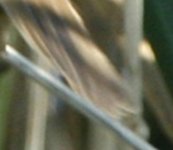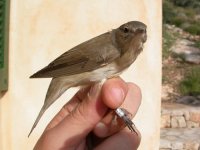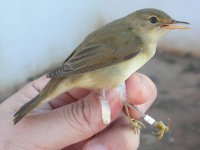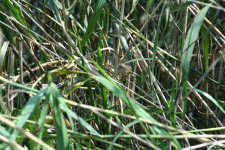-
Welcome to BirdForum, the internet's largest birding community with thousands of members from all over the world. The forums are dedicated to wild birds, birding, binoculars and equipment and all that goes with it.
Please register for an account to take part in the discussions in the forum, post your pictures in the gallery and more.
You are using an out of date browser. It may not display this or other websites correctly.
You should upgrade or use an alternative browser.
You should upgrade or use an alternative browser.
France, warbler (1 Viewer)
- Thread starter ekopa
- Start date
More options
Who Replied?First I was going to say that this second picture made a strong case for Reed. A Garden warbler with overall warm brown colors would be even weirder then a Reed Warbler with a Garden warbler like bill.
But then I started doubting again and I have a few more questions.
The darker patches on the tail are mostly caused by spots of shade. But towards the end there seem to be sunlit tail feather tips which are grayish, not brownish.
Also these tail feathers have light fringes, as in Motmot's Garden Warbler exemple.
And is this tail round enough for Reed?
Also both the Jonsson and Collins guide show a warmer brown rump for the Garden, and in the Collins that warmer coloration extends to halfway the tail.
Edited: I know thats probably more an argument for a birdwatcher like me, not for scientists that have studied every detail, but Jonsson an Collins are well thought of birdguides I believe.
So while I am doubting more then previously, I'm not convinced yet that this is a Reed warbler.
But then I started doubting again and I have a few more questions.
The darker patches on the tail are mostly caused by spots of shade. But towards the end there seem to be sunlit tail feather tips which are grayish, not brownish.
Also these tail feathers have light fringes, as in Motmot's Garden Warbler exemple.
And is this tail round enough for Reed?
Also both the Jonsson and Collins guide show a warmer brown rump for the Garden, and in the Collins that warmer coloration extends to halfway the tail.
Edited: I know thats probably more an argument for a birdwatcher like me, not for scientists that have studied every detail, but Jonsson an Collins are well thought of birdguides I believe.
So while I am doubting more then previously, I'm not convinced yet that this is a Reed warbler.
Last edited:
After having a good look, I believe this looks more like a Garden warbler tail.
Don't know how many feather we can't see, but of the ones we do see: Outer feather a mm or so longer, followed by two with equal lenght.
It may also be hard to fit the 12 tail feathers of a Reed in there
Ekopa, could you describe the general environment. It's not at all conclusive this time of the year, but a Garden warbler that wants to take a bath has to be near some form of water
Don't know how many feather we can't see, but of the ones we do see: Outer feather a mm or so longer, followed by two with equal lenght.
It may also be hard to fit the 12 tail feathers of a Reed in there
Ekopa, could you describe the general environment. It's not at all conclusive this time of the year, but a Garden warbler that wants to take a bath has to be near some form of water
Attachments
Motmot
Eduardo Amengual
That tail looks much darker than rump and back (back is in shadow so comparable). Garden doesn't show that marked contrast. Two more pics for comparison, now Garden under sunlight and Reed in shadow:
Attachments
Motmot
Eduardo Amengual
It may also be hard to fit the 12 tail feathers of a Reed in there
Same hard to fit the 12 tfs of a Garden
Ekopa, could you describe the general environment. It's not at all conclusive this time of the year, but a Garden warbler that wants to take a bath has to be near some form of water
It's on a lakeside, inside not very large reedbed, a mixed forest is just across the road, 5 meters away
Attachments
Ah, found the quote button
In your reference:
http://www.ibercajalav.net/img/373_GardenWarblerSborin.pdf
There are two that do have some form of contrast.
the first one, and top middle on the third page
But OK it's still a strong pro Reed argument
Ekopa, thanks, but as feared not very conclusive. But on the last pic at least the reed bed looks large enough for a normal Reed warbler environment. And a normal Garden environment 5 meters away definitly doesn't exclude Garden
That tail looks much darker than rump and back (back is in shadow so comparable). Garden doesn't show that marked contrast.
In your reference:
http://www.ibercajalav.net/img/373_GardenWarblerSborin.pdf
There are two that do have some form of contrast.
the first one, and top middle on the third page
But OK it's still a strong pro Reed argument
Ekopa, thanks, but as feared not very conclusive. But on the last pic at least the reed bed looks large enough for a normal Reed warbler environment. And a normal Garden environment 5 meters away definitly doesn't exclude Garden
Last edited:
dantheman
Bah humbug
First I was going to say that this second picture made a strong case for Reed. A Garden warbler with overall warm brown colors would be even weirder then a Reed Warbler with a Garden warbler like bill.
From the gallery here on Bf, some warm brown looking Garden Warblers;
http://www.birdforum.net/gallery/showphoto.php?photo=139011
http://www.birdforum.net/gallery/showphoto.php?photo=140648
http://www.birdforum.net/gallery/showphoto.php?photo=158765
http://www.birdforum.net/gallery/showphoto.php?photo=204376
http://www.birdforum.net/gallery/showphoto.php?photo=30793
Thanks Dan, that last pics f.i. looks a bit similar to our bird, also the face markings and the bill, the light spot on the hind toe.
Talking about hind toes, on both pics we have a reasonable view on them, and they look rather "standard" sized, while on a reed maybe they should look a bit more "oversized", compared to the tibia.
Talking about hind toes, on both pics we have a reasonable view on them, and they look rather "standard" sized, while on a reed maybe they should look a bit more "oversized", compared to the tibia.
jogresh
Bimble and patch
Interesting thread - goes to show yet again how risky it can be basing an ID on one photo. Fun though! It's funny, my first impression was Reed, but became quite happy with the idea of Garden - the bill does look short! And the facial expression which i initially thought was wrong for Garden, i managed to convince myself was actually OK!
Cheers.
Cheers.
Just thought of something,
Ekopa, in your first post you said the bird disappeared. Do you remember in what manner it disappeared and eventually where it went to.
If it just moved a bit to give you some room it would still be inconclusive, but if it really relocated itself, then reed and garden would chose different spots to go to.
Ekopa, in your first post you said the bird disappeared. Do you remember in what manner it disappeared and eventually where it went to.
If it just moved a bit to give you some room it would still be inconclusive, but if it really relocated itself, then reed and garden would chose different spots to go to.
Well with this particular one I am not sure. Either you take photos or you observe especially if you only have couple of seconds like in this case. My perception was it had gone deeper into the reedbed and stayed motionless and silent. However, I remeber that when I came to this place just a minute before a couple of similar birds made it back to the nearby forest.
so...
so...
Can' t find any calls on the web either, but sounds better for Garden at first sight.
I listened to my Roché CD's to be sure, alarm call of Reed is a longer call with a harsh sound, sort of krruuet. Garden's alarm is a shorter chekking, though slightly less harsh then some other Silvia warblers.
I listened to my Roché CD's to be sure, alarm call of Reed is a longer call with a harsh sound, sort of krruuet. Garden's alarm is a shorter chekking, though slightly less harsh then some other Silvia warblers.
KnockerNorton
Well-known member
I just tried to find on the web samples of both species calls (not songs). Something like harsh clicking or "chekking". If they are not too similar, probably I will be able to say more...
Garden give a hard 'tack' so if "harsh clicking or "chekking"" then that fits garden - reed gives a slightly buzzing 'dzrrrrr'.
The second pic gives a stong pro Reed colour, but I still can't square that bill with a Reed Warbler, and the links on this page show some interestingly warm-rumped Garden. Analysis of the tail isn't much use, as I don't think we can see enough. Talk of the hind claw is a red herring - it's of no use at all as far as I can tell (if anyone can give a link of the value of colur of hind toes as an i.d. criteria I'll happily change my mind), as I can think of plenty of reasons why it would vary.
It still comes down to the bill with me. What am I most willing to believe - that the photos have misrepresented the colour or misrepresented the bill? We all know how the camera can change colours, but I think we can see the bill clearly enough to see it's true shape/length in a good profile shot. So I'm still about 95% garden and 5% reed.
Talk of the hind claw is a red herring - it's of no use at all as far as I can tell (if anyone can give a link of the value of colur of hind toes as an i.d. criteria I'll happily change my mind), as I can think of plenty of reasons why it would vary.
You probably won't find any id article discussing the differences in toe colour between Reed Warbler and Garden Warbler.
http://www.bingsmarken.se/separation_juvenila.htm
I have never seen a Garden Warbler with yellow soles.
It still comes down to the bill with me. What am I most willing to believe - that the photos have misrepresented the colour or misrepresented the bill? We all know how the camera can change colours, but I think we can see the bill clearly enough to see it's true shape/length in a good profile shot.
As said previously, to me the bill looks good for a Reed Warbler with a not fully grown bill, but wrong for a Garden Warbler. The base is too thin and the culmen is not curved enough.
Regarding the calls, Reed Warbler has lots of different calls (which are described e.g. in the Collins guide).
CAU, drinks are on me B
CAU, congrats that you keep your's mind :t:
Thanks!
KnockerNorton
Well-known member
However, the toe colour is a useful character separating Reed Warblers from Marsh Warblers,
but is that validated anywhere? Any reliable studies? Or is it like the bib size on Marsh and Willow Tits - accepted wisdom that has been around for years, but is hypothesis presented as fact? (that turns out not to be true!). There seems to be no data on the sole colour of garden warblers, or variation on the sole colour of reed warblers, as far as i can find. In light of that, it's hard to put any credence on it.
As said previously, to me the bill looks good for a Reed Warbler with a not fully grown bill,[
but that is a physical impossibility - the bird has no trace of gape so is well beyond being a fledgling, so the bill is not growing. It may even be an adult.
JANJ
Well-known member
It´s worth noting that when CAU mention toe colour as a good separating feature between March and Reed, he actually is refering to claws, not toe. 
In his link the ringer is refering to contrast between pale legs and claws in March gives little contrast to yellow soles, darker legs and claws in Reed gives more contrast to yellow soles, if he forgive my explaining this.
However - leg colour is variable, and according to Svensson claw colour is more reliable.
I myself have never seen such yellow soles in Garden Warbler, but I have noted a few with pale straw soles.
Hinting here:
http://www.netfugl.dk/pictures.php?id=showpicture&picture_id=16781
http://www.birdpix.nl/album_page.php?pic_id=98305
By the end of the day - if this warbler eventually is identified it would not be by the colour of it´s soles.
JanJ
In his link the ringer is refering to contrast between pale legs and claws in March gives little contrast to yellow soles, darker legs and claws in Reed gives more contrast to yellow soles, if he forgive my explaining this.
However - leg colour is variable, and according to Svensson claw colour is more reliable.
I myself have never seen such yellow soles in Garden Warbler, but I have noted a few with pale straw soles.
Hinting here:
http://www.netfugl.dk/pictures.php?id=showpicture&picture_id=16781
http://www.birdpix.nl/album_page.php?pic_id=98305
By the end of the day - if this warbler eventually is identified it would not be by the colour of it´s soles.
JanJ
but that is a physical impossibility - the bird has no trace of gape so is well beyond being a fledgling, so the bill is not growing.
But is that validated anywhere? Any reliable studies? Or is it like the bib size on Marsh and Willow Tits - accepted wisdom that has been around for years, but is hypothesis presented as fact?
I still see no gape on this Reed Warbler, which has a clearly shorter bill than an adult:
http://cbcphotocomp.blogspot.com/2007_12_01_archive.html
Last edited:
Users who are viewing this thread
Total: 2 (members: 0, guests: 2)







